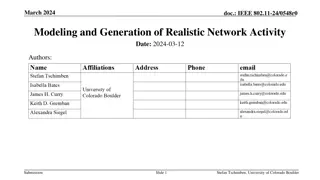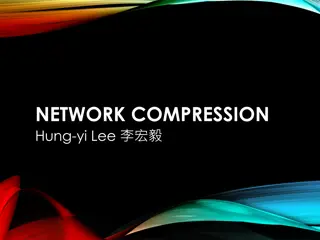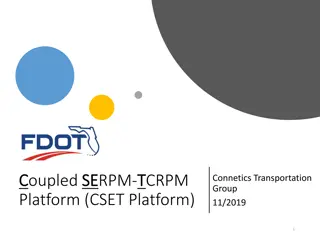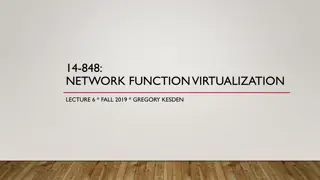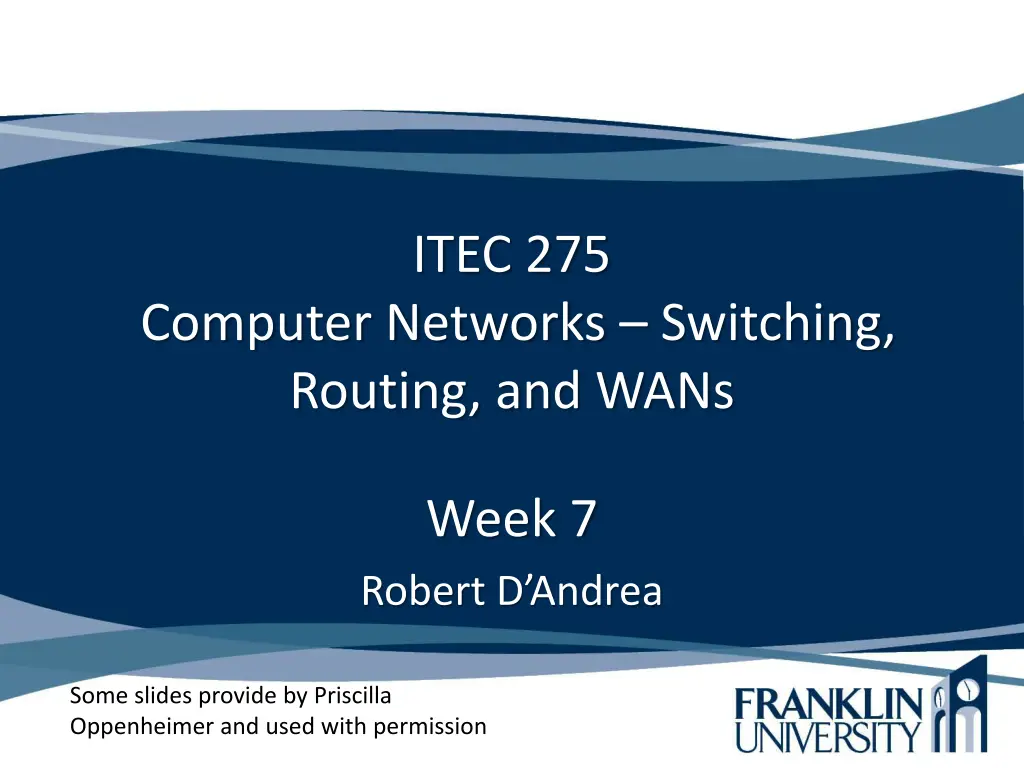
Understanding DNS Domain Names Hierarchy
Explore the hierarchy of DNS domain names, from interpreting fully qualified paths to understanding the levels within a domain name structure, such as subdomains and top-level domains. Gain insights into how DNS domain names are structured and interpreted, akin to navigating file paths on a computer system.
Download Presentation

Please find below an Image/Link to download the presentation.
The content on the website is provided AS IS for your information and personal use only. It may not be sold, licensed, or shared on other websites without obtaining consent from the author. If you encounter any issues during the download, it is possible that the publisher has removed the file from their server.
You are allowed to download the files provided on this website for personal or commercial use, subject to the condition that they are used lawfully. All files are the property of their respective owners.
The content on the website is provided AS IS for your information and personal use only. It may not be sold, licensed, or shared on other websites without obtaining consent from the author.
E N D
Presentation Transcript
ITEC 275 Computer Networks Switching, Routing, and WANs Week 7 Robert D Andrea Some slides provide by Priscilla Oppenheimer and used with permission
Agenda Learning Activities Domain Name Server (DNS) Summarization Root Owner DNS Routing tables Spanning Tree Protocol Rapid Spanning Tree Protocol Static versus Dynamic Routing Routing Protocols and Characteristics
Interpreting a DNS domain names DNS has a method of noting and interpreting the fully qualified path to a DNS domain name similar to the way full paths to files or directories are noted or displayed at a command prompt. the exact location of a file stored on your computer. For Windows computers, the back slash (\) indicates each new directory that leads to the exact location of a file. For DNS, the equivalent is a period (.) indicating each new domain level used in a name. For example, a directory tree path helps point to
Interpreting File Names UNIX uses the concept of relative and absolute file names. If a file name is preceded by a forward slash (e.g. /bin), the name is absolute. If the name is without a leading slash, it is considered relative to your current working directory.
Interpreting a DNS domain names For DNS, an example of a domain name with multiple levels is the following, a fully qualified domain name (FQDN): host-a.example.microsoft.com. Unlike the file name example, a DNS FQDN, when read from left to right, moves from its most specific information (the DNS name for a computer called "host- a") to its highest or most general piece of information (the trailing period (.) that indicates the root of the DNS name tree). This example shows the four separate DNS domain levels that lead away from the specific host location of "host-a":
Interpreting a DNS domain names 1. The "example" domain, which corresponds to a subdomain where the computer name "host-a" is registered for use. 2. The "microsoft" domain, which corresponds to the parent domain that roots the "example" subdomain. 3. The "com" domain, which corresponds to the top-level domain designated for use by business or commercial organizations that roots the "microsoft" domain. 4. The trailing period (.), which is a standard separator character used to qualify the full DNS domain name to the root level of the DNS namespace tree.
Root Servers When a computer on the Internet needs to resolve a domain name, it uses resolver software to do the lookup. A resolver breaks the name up into its labels from right to left. The first component is queried using a root server to obtain the responsible authoritative server. Queries for each name are performed until a name server returns the answer of the original query.
Interpreting a DNS domain names As of 2013, there are 13 root name servers, with names in the form letter.root-server.net. This does not mean that there are only 13 physical servers; each site uses redundant computer equipment to provide reliable service in when hardware and software fail on occasion. View: www.root-servers.org
Switching and Routing Choices Switching Layer 2 transparent bridging (switching) Multilayer switching Spanning Tree Protocol enhancements VLAN technologies Routing Static or dynamic Distance-vector and link-state protocols Interior and exterior Etc.
Selection Criteria for Switching and Routing Protocols Network traffic characteristics Bandwidth, memory, and CPU usage The number of peers supported The capability to adapt to changes quickly Support for authentication
Making Decisions Goals must be established Many options should be explored The consequences of the decision should be investigated Contingency plans should be made A decision table can be used. Decision tables are composed of rows and columns. Each row corresponds to a single rule, with the columns defining the conditions and actions of the rules.
Transparent Bridging (Switching) Tasks Ethernet switches and bridges use transparent bridging. A transparent bridge connects one or more LAN segments so that end systems on different segments can communicate with each other transparently. An end system sends a frame to a destination without knowing whether the destination is local or on the other side of the bridge.
Transparent Bridging (Switching) Tasks Forward frames transparently Learn which port to use for each MAC address Flood frames when the destination unicast address hasn t been learned yet Filter frames from going out ports that don t include the destination address Flood broadcasts and multicasts
Definitions STP is a bridge protocol that uses the STA (Spanning Tree Algorithm) to find redundant links dynamically and create a spanning-tree topology database. Bridges exchange BPDU (Bridge Protocol Data Unit) messages with other bridges to detect loops. BPDU STP hello packet that is sent out at configurable intervals to exchange information among bridges in the network.
Switching Table on a Bridge or Switch MAC Address Port 08-00-07-06-41-B9 1 2 00-00-0C-60-7C-01 3 00-80-24-07-8C-02
Cisco Spanning Tree Protocol Enhancements PortFast is a Cisco feature. It supports the concept of a switch edge port. UplinkFast and Backbone Fast. UpLinkFast is a Cisco feature that is configured on access layer switches. Improves the convergence time of STP. Unidirectional link detection is a hardware failure detection between switches. Loop Guard is a Cisco product. Supports the prevention of loops caused by blocking port erroneously moving to the forwarding state.
Redundant Uplinks Core Layer X Distribution Layer Switch B Switch C Primary Uplink Secondary Uplink X Access Layer X = blocked by STP Switch A If a link fails, how long will STP take to recover? Use UplinkFast to speed convergence
Protocols for Transporting VLAN Information Inter-Switch Link (ISL) Tagging protocol Cisco proprietary IEEE 802.1Q Tagging protocol IEEE standard VLAN Trunk Protocol (VTP) VLAN management protocol is a switch-to-switch and switch-to-router configuration.
Protocols for Transporting VLAN Information VLAN Trunk Protocol (VTP) The VLAN management protocol exchanges VLAN configuration changes as they are made to the network. VTP manages additions, deletions, and renaming of VLANs on a campus network without requiring manual intervention at each switch.
Selecting Routing Protocols They all have the same general goal: To share network reachability information among routers They differ in many ways: Interior versus exterior Metrics supported hop count or bandwidth. Dynamic versus static and default Distance-vector versus link-sate Classful versus classless Scalability
Interior Versus Exterior Routing Protocols Interior routing protocols are used within an autonomous system Exterior routing protocols are used between autonomous systems Autonomous system (two definitions that are often used): A set of routers that presents a common routing policy to the internetwork A network or set of networks that are under the administrative control of a single entity
Routing Protocol Metrics Metric: the determining factor used by a routing algorithm to decide which route to a network is better than another Examples of metrics: Bandwidth - capacity Delay - time Load - amount of network traffic Reliability - error rate Hop count - number of routers that a packet must travel through before reaching the destination network Cost - arbitrary value defined by the protocol or administrator
Routing Algorithms Static routing Calculated beforehand, offline Default routing If I don t recognize the destination, just send the packet to Router X Cisco s On-Demand Routing Routing for stub networks Uses Cisco Discovery Protocol (CDP) Dynamic routing protocol Distance-vector algorithms Link-state algorithms
Routing Algorithms Stub network has only one default path to non-local hosts and no outside network knowledge. Non-local stub network traffic uses a single logical path when traveling in and out of the network. A good example would be an individual or group that uses only one router to link to an internet service provider (ISP). The individual or group are considered stub networks by the ISP.
Routing Algorithms The default route is the IP address of the next hop when no other routes are known. To configure the default route to be 192.168.1.1: config t ip route 0.0.0.0 0.0.0.0 192.168.1.1 An interface can be used as an alternative to and IP address. To use serial0/0 for destinations not in the routing table, use: ip route 0.0.0.0 0.0.0.0 serial 0/0
Routing Algorithms Adefault route of a computer that is participating in computer networking is the packet forwarding rule (route) taking effect when no other route can be determined for a given Internet Protocol (IP) destination address. All packets for destinations not established in the routing table are sent via the default route. This route generally points to another router, which treats the packet the same way: If a route matches, the packet is forwarded accordingly, otherwise the packet is forwarded to the default route of that router. The process repeats until a packet is delivered to the destination. Each router traversal counts as one hop in the distance calculation for the transmission path.
Routing Algorithms Cisco s On- Demand Routing The Cisco Discovery Protocol (CDP) is a Cisco proprietary protocol that, amongst other things, is used to discover other Cisco devices on either broadcast or non-broadcast media. CDP provides administrators with information that includes the IP address, software version, as well as the capabilities of the neighbor device. On-Demand Routing is an enhancement to Cisco Discovery Protocol that advertises the connected IP prefix or prefixes of a stub router via CDP. ODR also supports VLSM (Variable Length Subnet Mask), which means that it can be used in just about any network.
Routing Algorithms Cisco s On- Demand Routing It is important to know that ODR is not a routing protocol. Instead, it is simply an enhancement to CDP that is used to dynamically propagate routing information at Layer 2. The primary reasons ODR is often incorrectly referred to as a routing protocol is because it allows routers to dynamically exchange routing information. The second reason is because ODR is enabled using the router odr global configuration command.
Routing Algorithms Cisco s On- Demand Routing The primary benefits of using ODR is that it is not CPU intensive and it consumes very little bandwidth.
Routing Algorithms Cisco s On- Demand Routing
Static Routing Example 172.16.20.1 172.16.20.2 172.16.40.1 172.16.40.2 Router A Router B Router C s0 s0 s0 s1 e0 e0 e0 172.16.10.1 172.16.30.1 172.16.50.1 Host A Host B Host C 172.16.10.2 172.16.30.2 172.16.50.2 RouterA(config)#ip route 172.16.50.0 255.255.255.0 172.16.20.2 Send packets for subnet 50 to 172.16.20.2 (Router B)
Default Routing Example 172.16.20.1 172.16.20.2 172.16.40.1 172.16.40.2 Router A Router B Router C s0 s0 s0 s1 e0 e0 e0 172.16.30.1 172.16.50.1 172.16.10.1 Host A Host B Host C 172.16.10.2 172.16.30.2 172.16.50.2 RouterA(config)#ip route 0.0.0.0 0.0.0.0 172.16.20.2 If it s not local, send it to 172.16.20.2 (Router B)
Distance-Vector Routing Router maintains a routing table that lists known networks, direction (vector) to each network, and the distance to each network Router periodically (every 30 seconds, for example) transmits the routing table via a broadcast packet that reaches all other routers on the local segments Routers update their routing table, if necessary, based on received broadcasts
Distance-Vector Routing Tables Router A Router B 172.16.0.0 192.168.2.0 Router A s Routing Table Router B s Routing Table Network Distance Send To Network Distance Send To 172.16.0.0 192.168.2.0 0 1 Port 1 Router B 192.168.2.0 172.16.0.0 0 1 Port 1 Router A
Link-State Routing Routers send updates only when there s a change Router that detects change creates a link-state advertisement (LSA) and sends it to neighbors Neighbors propagate the change to their neighbors Routers update their topological database if necessary
Distance-Vector Vs. Link-State Distance-vector algorithms keep a list of networks, with next hop and distance (metric) information Link-state algorithms keep a database of routers and links between them Link-state algorithms think of the internetwork as a graph instead of a list When changes occur, link-state algorithms apply Dijkstra s shortest-path algorithm to find the shortest path between any two nodes
Choosing Between Distance-Vector and Link-State Choose Distance-Vector Simple, flat topology Hub-and-spoke topology Junior network administrators Convergence time not a big concern Choose Link-State Hierarchical topology More senior network administrators Fast convergence is critical
Choosing between Distance Vector and Link State Protocols Distance-Vector Routing Information Protocol (RIP) Version 1 and 2 Interior Gateway Routing Protocol (IGRP) Enhanced IGRP Border Gateway Protocol (BGP) Link-State Open Shortest Path First (OSPF) Intermediate System-to- Intermediate System (IS-IS)
Routing Protocol View: http://www.youtube.com/watch?v=CBDdM-imW7o
Dynamic Routing Protocols View: http://www.youtube.com/watch?v=gXOKjnZR4Tg
Routing Information Protocol (RIP) First standard routing protocol developed for TCP/IP environments RIP Version 1 is documented in RFC 1058 (1988) RIP Version 2 is documented in RFC 2453 (1998) Easy to configure and troubleshoot Broadcasts its routing table every 30 seconds; 25 routes per packet Uses a single routing metric (hop count) to measure the distance to a destination network; max hop count is 15

